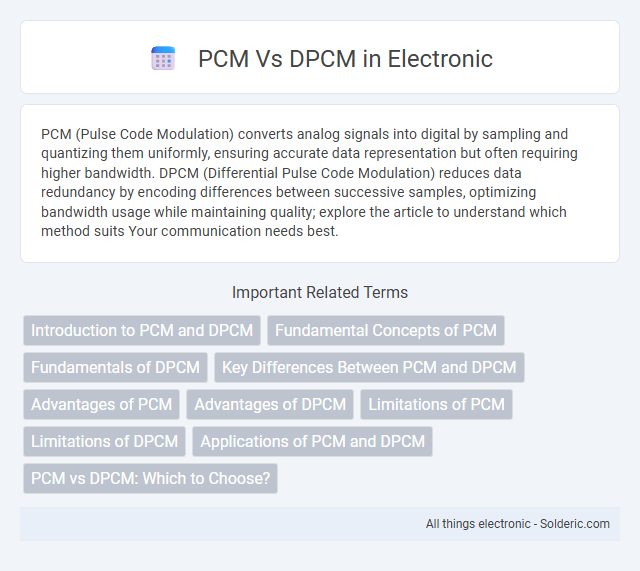PCM (Pulse Code Modulation) converts analog signals into digital by sampling and quantizing them uniformly, ensuring accurate data representation but often requiring higher bandwidth. DPCM (Differential Pulse Code Modulation) reduces data redundancy by encoding differences between successive samples, optimizing bandwidth usage while maintaining quality; explore the article to understand which method suits Your communication needs best.
Comparison Table
| Feature | PCM (Pulse Code Modulation) | DPCM (Differential Pulse Code Modulation) |
|---|---|---|
| Definition | Encodes absolute signal samples into digital form. | Encodes difference between consecutive samples. |
| Data Rate | Higher data rate due to full sample encoding. | Lower data rate by encoding differences. |
| Complexity | Simple encoder and decoder. | More complex due to prediction and differencing. |
| Compression | No inherent compression. | Provides data compression by reducing redundancy. |
| Application | Standard in digital telephony and audio. | Used in low bitrate audio coding and video compression. |
| Noise Sensitivity | Less sensitive to error propagation. | More sensitive due to error accumulation in prediction. |
Introduction to PCM and DPCM
Pulse Code Modulation (PCM) is a digital representation method where analog signals are sampled at uniform intervals and quantized into discrete digital values, ensuring high-fidelity audio transmission. Differential Pulse Code Modulation (DPCM) enhances PCM by encoding the difference between successive samples, reducing redundancy and improving compression efficiency. Understanding the distinction between PCM and DPCM helps you optimize digital signal processing for better bandwidth utilization.
Fundamental Concepts of PCM
Pulse Code Modulation (PCM) involves sampling an analog signal at uniform intervals and converting these samples into a digital binary format, preserving the signal's amplitude information accurately. This technique relies on quantization and encoding processes to transform continuous waveform amplitudes into discrete values, facilitating efficient digital transmission and storage. Your understanding of PCM's fundamental concept is crucial for grasping how digital communication systems convert analog inputs into reliable digital signals.
Fundamentals of DPCM
Differential Pulse Code Modulation (DPCM) enhances traditional Pulse Code Modulation (PCM) by encoding the difference between consecutive samples rather than the absolute sample values, effectively reducing redundancy in signals with high temporal correlation. By predicting the current sample based on previous samples and encoding only the error or difference, DPCM achieves improved compression efficiency and lower bit rates. This fundamental approach makes DPCM particularly suitable for speech and audio signals where adjacent samples exhibit strong correlation, enabling more efficient transmission and storage compared to standard PCM.
Key Differences Between PCM and DPCM
Pulse Code Modulation (PCM) encodes analog signals into digital binary form by sampling at uniform intervals, representing each sample with a fixed number of bits, while Differential Pulse Code Modulation (DPCM) encodes the difference between consecutive samples, reducing redundancy and bandwidth usage. PCM typically requires higher bit rates due to independent sample encoding, whereas DPCM achieves better compression by exploiting signal correlation, resulting in lower bit rates for similar quality. The primary distinction lies in PCM's direct amplitude quantization versus DPCM's prediction-based error encoding, optimizing data efficiency in digital communication.
Advantages of PCM
PCM (Pulse Code Modulation) offers superior noise immunity and higher signal fidelity compared to DPCM (Differential Pulse Code Modulation) due to its direct representation of analog signals into binary form without approximation. The simplicity of PCM encoding and decoding processes ensures robust performance in various communication systems, minimizing quantization errors prevalent in differential schemes. PCM's straightforward implementation makes it ideal for applications demanding high-quality audio and precise digital signal transmission.
Advantages of DPCM
DPCM (Differential Pulse Code Modulation) offers significant advantages over PCM (Pulse Code Modulation) by reducing the bit rate required for signal transmission through encoding the difference between successive samples rather than absolute values, leading to more efficient bandwidth utilization. This differential encoding approach minimizes redundancy in signals with high temporal correlation, resulting in better compression and lower storage requirements. DPCM also enhances noise immunity and reduces quantization error, improving overall signal quality in communication systems.
Limitations of PCM
Pulse Code Modulation (PCM) suffers from significant limitations, including high bandwidth requirements due to its direct sampling and quantization of analog signals, which leads to large data rates for transmission. PCM is also susceptible to quantization noise, which can degrade signal quality, especially at lower bit depths. These constraints make PCM less efficient compared to Differential Pulse Code Modulation (DPCM), which reduces redundancy by encoding the difference between successive samples, thereby optimizing bandwidth and improving noise performance.
Limitations of DPCM
DPCM (Differential Pulse Code Modulation) reduces redundancy by encoding the difference between successive samples, but it struggles with rapid signal changes, leading to quantization noise and error accumulation. Unlike PCM (Pulse Code Modulation), DPCM's prediction errors can cause distortion in signals with high frequency content or abrupt transitions. Your audio or data transmission quality may degrade if DPCM is used in environments with high signal variability.
Applications of PCM and DPCM
PCM (Pulse Code Modulation) is widely used in digital telephony, audio recording, and broadcasting due to its straightforward encoding of analog signals into digital form, ensuring high-fidelity sound reproduction in CD and DVD audio formats. DPCM (Differential Pulse Code Modulation) finds strong application in video compression, speech coding, and image transmission systems, where it reduces redundancy by encoding differences between successive samples, leading to efficient bandwidth usage. Both PCM and DPCM play crucial roles in communication systems, with PCM favored for precise signal representation and DPCM optimized for data compression and transmission efficiency.
PCM vs DPCM: Which to Choose?
PCM (Pulse Code Modulation) offers straightforward digital representation of analog signals with consistent bit rates, making it ideal for high-fidelity audio applications. DPCM (Differential Pulse Code Modulation) reduces redundancy by encoding differences between samples, effectively lowering bandwidth requirements without significant loss in quality. Choosing between PCM and DPCM depends on the specific needs for bandwidth efficiency and signal fidelity, with PCM preferred for simplicity and quality, while DPCM suits bandwidth-constrained environments.
PCM vs DPCM Infographic

 solderic.com
solderic.com